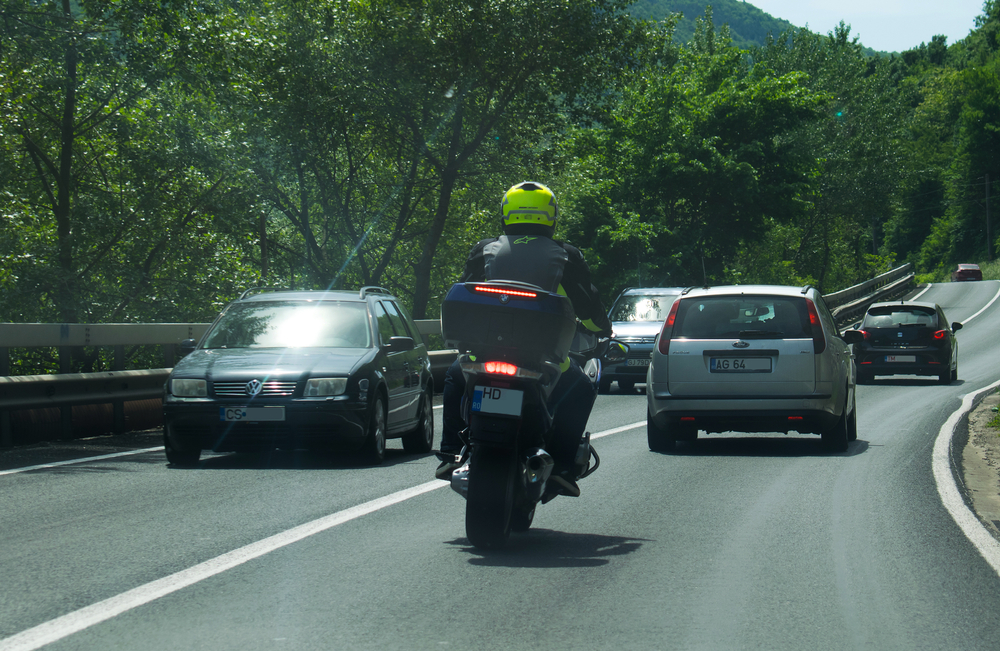
Author: John Mattiacci | Owner Mattiacci Law
Published March 16, 2025

Table of Contents
ToggleRiding a motorcycle through heavy traffic can be frustrating, leading many riders to ask: Is lane split in Pennsylvania legal?
Lane splitting is illegal in Pennsylvania. Motorcyclists must occupy a full lane and are prohibited from riding between lanes of slow-moving or stopped traffic. Violators may face fines, points on their license, and increased liability in accidents.
With decades of experience handling motorcycle accident cases in Pennsylvania, I’ve helped countless riders understand their rights and pursue fair compensation after accidents involving lane splitting.
In this article, I’ll explain Pennsylvania’s lane splitting laws, compare them to other states, discuss potential penalties, and cover what motorcyclists should know to stay safe and protect their legal rights.

What Is Lane Splitting?
Lane splitting, often referred to as “white-lining,” is when a motorcyclist navigates between lanes of traffic, weaving through slow-moving or stationary vehicles. This maneuver is commonly debated for its potential safety benefits and risks.
Motorcyclists may also engage in:
- Lane Filtering: Moving between lanes at lower speeds to filter to the front of stopped traffic.
- Lane Sharing: Riding side-by-side with another motorcyclist in the same lane.
While some states allow lane splitting or filtering, Pennsylvania law explicitly prohibits these maneuvers.
What Is the Difference Between Lane Splitting and Lane Filtering?
Many riders confuse lane splitting and lane filtering, but they are legally distinct maneuvers with different implications.
Lane splitting occurs when a motorcyclist rides between lanes of moving traffic, while lane filtering happens when a motorcyclist moves between lanes of stopped or slow-moving vehicles at low speeds.
Key Differences Between Lane Splitting and Lane Filtering
| Feature | Lane Splitting | Lane Filtering |
|---|---|---|
| Definition | Riding between lanes of moving traffic | Moving between lanes of stopped or slow-moving traffic |
| Speed | Typically at highway speeds or in congested traffic | Low-speed maneuver, usually under 15-20 mph |
| Legal in PA? | ❌ Illegal | ❌ Illegal |
| Allowed States | ✅ California only | ✅ Arizona, Utah, Montana, Hawaii, Colorado |
| Safety Concerns | Risk of sudden lane changes by cars | Lower risk, but still dependent on driver awareness |
| Goal | Helps motorcyclists move efficiently through traffic | Reduces stop-and-go risks, prevents rear-end collisions |
In Pennsylvania, both lane splitting and lane filtering are illegal under state law. Motorcyclists must always occupy a full lane and are not allowed to pass between cars, even in stopped traffic.
California is the only state where lane splitting is fully legal, while states like Arizona, Utah, and Montana allow lane filtering under specific conditions.
Motorcyclists should always check local laws before attempting either maneuver, as unauthorized lane splitting or filtering can result in fines, liability in accidents, and increased insurance costs.
Is Lane Splitting Legal in Pennsylvania?
Lane splitting is illegal in Pennsylvania under 75 Pa. C.S. § 3523. Motorcycles must use an entire lane, and riding between lanes of traffic is prohibited.
Under Pennsylvania law:
- Motorcycles are entitled to full lane use – meaning cars cannot crowd them out of a lane.
- Lane splitting is not permitted, even in heavy traffic or at stoplights.
- Lane sharing is allowed – two motorcycles can ride side-by-side in the same lane.
This means that while riders can share a lane with another motorcycle, they cannot move between cars or ride on the white lines to bypass traffic.
Why Is Lane Splitting Illegal in Pennsylvania?
Lane splitting is illegal in Pennsylvania due to safety concerns, including limited driver visibility, sudden lane changes, and unpredictable road conditions.
Legislators and traffic safety officials argue that:
- Drivers may not expect motorcycles to pass between lanes, increasing the risk of sudden collisions.
- Limited space between vehicles creates hazardous conditions for motorcyclists, especially at high speeds.
- Pennsylvania’s traffic laws prioritize safety by requiring motorcycles to follow standard lane use rules.
Despite arguments that lane splitting can reduce congestion and prevent rear-end collisions, Pennsylvania has not proposed any legislation to legalize the practice.
Where in the U.S. Is Lane Splitting Legal?
Lane splitting is fully legal only in California, while several states allow lane filtering under specific conditions.
Motorcycle lane splitting laws vary widely across the United States. Below is a state-by-state breakdown of current laws regarding lane splitting and filtering as of 2025:
Lane Splitting Laws by State
| State | Lane Splitting | Lane Filtering | Notes |
|---|---|---|---|
| California | ✅ Legal | ✅ Allowed | Only state where lane splitting is fully legal. |
| Arizona | ❌ Illegal | ✅ Legal | Allowed at stops on roads with a 45 mph limit, motorcyclists must not exceed 15 mph. |
| Utah | ❌ Illegal | ✅ Legal | Permitted when traffic is stopped, and motorcycles move at 15 mph or less. |
| Montana | ❌ Illegal | ✅ Legal | Allowed when traffic is stopped or moving at 10 mph or less, motorcyclists must not exceed 20 mph. |
| Colorado | ❌ Illegal | ✅ Legal (as of Aug. 2024) | Allowed at red lights when vehicles are stopped, motorcycles must pass on the left and not exceed 15 mph. |
| Hawaii | ❌ Illegal | ⚠️ Shoulder Surfing Allowed | Motorcycles can use the shoulder to pass stopped traffic but not split lanes. |
| Texas | ❌ Illegal | ❌ Illegal | No law permitting lane splitting or filtering. |
| New York | ❌ Illegal | ❌ Illegal | Lane splitting is explicitly prohibited by state law. |
| Pennsylvania | ❌ Illegal | ❌ Illegal | Motorcyclists must use a full lane and cannot ride between cars. |
| Florida | ❌ Illegal | ❌ Illegal | Prohibited under state traffic laws. |
| All Other States | ❌ Illegal | ❌ Illegal | No law allowing lane splitting or filtering. |

Can Bicycles Lane Split in Pennsylvania?
Bicycles cannot legally lane split in Pennsylvania. Cyclists must follow the same traffic laws as motor vehicles.
However, Pennsylvania law does allow cyclists to:
- Use bike lanes when available.
- Ride as far to the right as practicable.
- Pass vehicles when safe, but not between lanes of moving traffic.
Contact Mattiacci Law for Motorcycle Accident Representation
If you were injured in a motorcycle accident in Pennsylvania, whether due to a negligent driver or a dispute over liability, you need experienced legal representation to protect your rights. At Mattiacci Law, we fight aggressively to help injured riders recover compensation for medical expenses, lost wages, and pain and suffering.
Call us today at (215) 914-6919 to schedule a free no-obligation consultation. We don’t charge any fees unless we win your case.
Related Articles:
- Do Motorcycles Stop Faster Than Cars?
- What Should I Do After a Motorcycle Accident in Philadelphia?
- How Much is the Average Motorcycle Accident Settlement in Pennsylvania?
- Pennsylvania Scooter Laws
Reference:
- Pennsylvania Department of Transportation (PennDOT)
- National Highway Traffic Safety Administration (NHTSA)
- Motorcycle Safety Foundation (MSF)
- Philadelphia Bicycle Laws
FAQs About Lane Splitting in Pennsylvania
Can motorcycles split lanes in Pennsylvania?
What happens if a motorcyclist gets caught lane splitting?
Can two motorcycles ride next to each other in Pennsylvania?
Is lane splitting legal in Texas?
Can bicycles lane split in Pennsylvania?
Is it illegal to ride a bicycle on the sidewalk in Pennsylvania?
Why is lane splitting illegal in Florida?
Categories
- Bicycle Accidents
- Brain Injuries
- Burn Injuries
- Bus Accidents
- Car Accidents
- Construction Accidents
- COVID-19
- Dog Bites
- Drunk Driving
- Injury Insurance
- Medical Malpractice
- Motorcycle Accidents
- Pain and Suffering
- Pedestrian Accidents
- Personal Injury
- Premises Liability
- Product Liability
- Rideshare Accidents
- Settlements & Awards
- Slip and Fall
- Truck Accidents
- Worker's Compensation
- Wrongful Death
